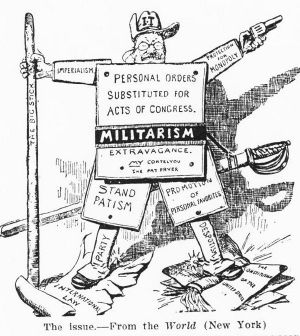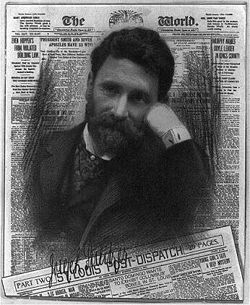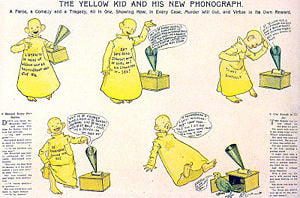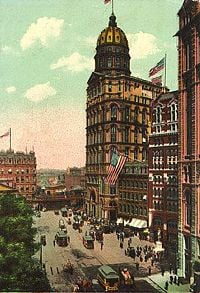Joseph Pulitzer
Joseph Pulitzer (April 18, 1847 â October 29, 1911) was a Hungarian-American publisher best known for establishing the prestigious Pulitzer Prizes for excellence in journalism. Along with William Randolph Hearst he was also responsible for originating yellow journalism. He operated several newspapers throughout his life, geared towards âlively human-interest stories, scandal, and sensational material,â exposing fraud and political corruption as well as introducing comic strips and other entertainment sections to make for more lively reading. Although for a while he focused on increasing sales by any means possible, later in life Pulitzer abandoned this approach, investing instead in quality journalism, particularly investigative reporting to reveal social problems. He thus sought to establish the school of journalism at Columbia University and the prizes that bear his name to ensure excellence in his profession.
Life
Pulitzer was born on April 18, 1847 in MakĂł, in present-day Hungary. His father was a wealthy grain merchant of Magyar-Jewish descent and his mother a devout Roman Catholic German. His younger brother, Albert, was trained for the priesthood but never attained it. Joseph grew up in Budapest and was educated there in private schools and by tutors. He sought a military career, but was turned down by the Austrian army for frail health and poor eyesight.
Pulitzer immigrated to the United States as a young man in 1864, and served in the 1st New York Cavalry during the American Civil War. He made his way to Saint Louis, Missouri after the war and in 1868 began working for the German language newspaper the Westliche Post. Ambitious and hardworking, Pulitzer studied English and law and served in the Missouri legislature, and by 1872 he was the owner and publisher of the Post.
By age 31, he had acquired a comfortable sum of money and married Kate Davis, a high class socialite of good standing.[1] In 1878 he bought The Evening Dispatch and merged the two newspapers into the St. Louis Post-Dispatch.
By then a wealthy man, Pulitzer moved to New York City in 1882 and purchased the New York World, a newspaper that had been losing $40,000 a year, for $346,000 from Jay Gould. Pulitzer shifted its focus to human interest stories, scandal, and sensationalism. From there he founded the New York Evening World (1887) and became one of the most powerful newspaper publishers in the United States, a rival and competitor of William Randolph Hearst.[2]
The later 1880s, up until 1890, saw a series of mudslinging campaigns directed at Pulitzer's credibility and his religion. The result of this was a serious lapse in his health, which combined with partial blindness, kept him from his offices. However, he still directed his papers and managed to compete with Hearst in a series of sensationalist press battles coined as yellow journalism. This culminated in the United States' entry into the Spanish-American War after both Hearst and Pulitzer embellished news stories of Spanish cruelty on Cuban soil, and Spain's attacks on United States naval ships.[2]
As his health failed and nearly blind, Pulitzer grew reclusive and spent most of his final years sailing the oceans of the world. He edited his papers by telegram and filled his life with classical literature. Pulitzer died aboard his yacht in the harbor at Charleston, South Carolina on October 29, 1911. His will called for the creation of the Graduate School of Journalism at Columbia University in order to further professionalism, and endowed the prizes for excellence that bear his name, the Pulitzer Prize.[2]
In 1989 Pulitzer was inducted into the St. Louis Walk of Fame.[3]
Career
Politics
Pulitzer was nominated for the Missouri state legislature in 1869 by the Republicans. His candidacy was considered a joke because he was nominated in a Democratic district. Pulitzer, however, ran seriously and won. In the legislature he fought graft and corruption. Pulitzer was highly criticized for a situation involving a lobbyist. An argument on the legislature floor had ensued and Pulitzer shot the lobbyist, wounding him in the leg. This caused a widespread controversy and many called for Pulitzer to be removed from office. He was remained, but he lost much credibility in the local government.[1]
Journalism Career
Industrious and ambitious, Pulitzer bought the St. Louis Post for about $3,000 in 1872. Next, he bought a German paper which had an Associated Press membership and then sold it to the owner of the Globe at a $20,000 profit. In 1878 Pulitzer purchased the bankrupt St. Louis Dispatch at a sheriff's sale for $2,700. He combined it with the Post. Aided by his brilliant editor-in-chief, John A. Cockerill, Pulitzer launched crusades against lotteries, gambling, tax dodging, mounted drives for cleaning and repairing the streets, and sought to make St. Louis more civic-minded. The Post-Dispatch became a success, and remains St. Louis' daily newspaper.
In 1883, Pulitzer, then 36, purchased the New York World for $346,000 from unscrupulous financier Jay Gould, who was losing $40,000 a year on the paper. Pulitzer made the down payment from Post-Dispatch profits and made all later payments out of profits from the World.
When fundraising for the pedestal of the Statue of Liberty was going slowly, Pulitzer opened up the editorial pages of his New York World newspaper to support the effort. Pulitzer used his newspaper to criticize both the rich, who had failed to finance the pedestal construction, and the middle class, who were content to rely upon the wealthy to provide the funds.[4] Pulitzer's campaign of harsh criticism was successful in motivating the people of America to donate. (It also promoted his newspaper, which purportedly added ~50,000 subscribers in the course of the statue campaign effort.)
In the 1880s Pulitzer's eyes began to fail. He went blind in 1889. During his battle for supremacy with William Randolph Hearst, publisher of the New York Journal, Pulitzer had to rely on a battery of secretaries to be his eyes. In New York he pledged the World to "expose all fraud and sham, fight all public evils and abuses" and to "battle for the people with earnest sincerity." He concentrated on lively human-interest stories, scandal, and sensational material. Pulitzer's World was a strong supporter of the common man. It was anti-monopoly and frequently pro-union during strikes.
Pulitzer in the early part of his career opposed the large headlines and illustrations. In 1895, however, the World introduced the immensely popular The Yellow Kid cartoons by Richard F. Outcault, the first newspaper comic strip printed with color. Around the same time, in a circulation contest between Hearst and Pulitzer, the two giants went to ever larger headline type and fantastic "x-marks-the-spot" art and indulged in questionable practices until Pulitzer lost stomach for such dubious work and cut back.
Pulitzer defended sensationalism, however, saying that people had to know about crime in order to combat it. He once told a critic, "I want to talk to a nation, not a select committee." This sensationalism became known as âyellow journalism,â unethical or unprofessional practices associated with journalism in order to boost sales or grab attention. The Pulitzer v. Hearst news battles of the 1890s created the term, and it has been suggested (albeit without serious merit) that the yellow journalism of both Pulitzer and Hearst drew the United States into the Spanish-American War in 1898.
Towards the end of Pulitzer's career, the World exposed a fraudulent payment of $40 million by the United States to the French Panama Canal Company in 1909. Pulitzer was indicted for libeling Theodore Roosevelt and J. P. Morgan. The courts eventually dismissed the indictments, in a victory for freedom of the press.
New York World
The New York World newspaper was published in New York City from 1860 until 1931, unsuccessful until Pulitzer purchased it in 1883. Nellie Bly, a reporter on the paper, became one of America's first investigative journalists, often working undercover. As a publicity stunt for the paper inspired by the Jules Verne novel Around the World in Eighty Days, she traveled around the planet in 72 days. In 1890 Pulitzer built the New York World Building, the tallest office building in the world at the time. It was razed in 1955 to make way for a new approach to the Brooklyn Bridge.
Pulitzer's leadership of the World in the mid to late 1890s was attacked for being "sensational," and its later circulation battles with Hearst's Journal American gave rise to the term yellow journalism. Pulitzer strove to make the New York World an entertaining read, and filled his paper with pictures, games, and contests that drew in readers, particularly those who used English as a second language. Crime stories filled many of the pages, with headlines like "Was He a Suicide?" and "Screaming for Mercy."[5] One should note, however, that the charges of sensationalism were most frequently leveled at the paper by more established publishers, who resented Pulitzer's courting of the immigrant classes. And while the World presented its fair share of crime stories, it also published damning exposés of tenement abuses.
After a heat wave in 1883 killed a disproportionate number of children and led the World to publish stories under headlines like "Lines of Little Hearses," the adverse publicity spurred action for reform. Hearst reproduced Pulitzer's approach in the San Francisco Examiner and later in the Journal American.
In his New York World, Pulitzer emphasized illustrations, advertising, and a culture of consumption for working men who, Pulitzer believed, saved money to enjoy life with their families when they could be at Coney Island, for example.[2] The paper published the first crossword puzzle in December 1913. The annual World Almanac was founded by the newspaper and retains its name.
By contrast, long-established editor Charles A. Dana, of the New York Sun, held to a traditional view of the working man as one engaged in a struggle to better his working conditions and to improve himself. Dana thought the twentieth century would see even fewer faddish illustrations and wished newspapers did not need advertising. Dana resisted buying a linotype. These two editors, and their newspapers, reflected two worldsâone old, one newâand Pulitzer won.

Pulitzer employed Frank Irving Cobb (1869-1923) on a trial basis as the editor of the World in 1904. Cobb was a fiercely independent Kansan who resisted Pulitzer's attempts to "run the office" from his home. Time after time these men battled each other, and not often in the most temperate language. Ironically, both men found common ground in their support of Woodrow Wilson. But there were plenty of other issues to disagree about. When Pulitzer's son took over administrative responsibility in 1907, Pulitzer wrote a precisely worded resignation which was printed in every New York paperâexcept the World. Pulitzer raged at the insult, but slowly began to respect Cobb's editorials and independent spirit. Exchanges, commentaries, and messages between them increased, and this resulted in a strong rapport. Pulitzer's demands for editorials on contemporary breaking news led to overwork for Cobb, risking his health. Pulitzer revealed concern by sending him on a six-week tour of Europe to restore his spirit. Pulitzer died shortly after Cobb's return in 1911; Cobb then published Pulitzer's beautifully written resignation. Cobb retained the editorial policies he had shared with Pulitzer until he died of cancer in 1923.[6]
In 1931, the heirs of Pulitzer went to court to sell the World. A surrogate court judge decided in the Pulitzer sons' favor; it was purchased by Roy Howard for his Scripps-Howard chain. He promptly closed the World and laid off the staff of three thousand after the final issue was printed February 27, 1931. Howard added the World name to his afternoon paper, the Evening Telegram and called it the New York World-Telegram.
Legacy
Joseph Pulitzer has been called "the midwife to the birth of the modern mass media."[7] His sensationalist approach to journalism, exposing fraud and political corruption as well as introducing comic strips to provide more entertaining reading for the public, has left a lasting imprint on the media.
In 1892, Pulitzer offered Columbia University's president, Seth Low, money to set up the world's first school of journalism. The university initially turned down the money, evidently unimpressed by Pulitzer's unscrupulous character. In 1902, Columbia's new president Nicholas Murray Butler was more receptive to the plan for a school and prizes, but it would not be until after Pulitzer's death that this dream would be fulfilled. Pulitzer left the university two million dollars in his will, which led to the creation in 1912 of the Columbia University Graduate School of Journalism, but by then the first school of journalism had been created at the University of Missouri. Columbia's Graduate School of Journalism remains one of the most prestigious in the world.
Pulitzer Prize
One of Pulitzer's original stipulations for the journalism school detailed an annual prize to journalists for accomplishments in the field. Pulitzer decreed that prizes would be awarded once the school was running successfully for three years. The Columbia School of Journalism opened in 1912, and the first Pulitzer Prizes were awarded in 1917.[1] The prizes continue to be rewarded to this day, with a large portion of the prizes going to journalists who expose government corruption or the abuse of civil liberties. The prize was originally awarded with a monetary gift of five hundred thousand dollars directly from Joseph Pulitzer, but the financial gift is much smaller now. Today, Pulitzer Prizes are awarded not only to journalism, but to letters, music, and as fellowships. More than 2,400 applicants are taken for the prize every year.[8][9]
Major Works
Pulitzer was involved in the creation and upbringing of many different newspapers. Below are an example of some of the papers he was involved in and the books he wrote:
- Pulitzer, Joseph, Horace White, and Michael Perry. [1904] 2006. The School of Journalism in Columbia University: The Book That Transformed Journalism from a Trade into a Profession. Inkling Books. ISBN 1587420570
- St. Louis Post-Dispatch, which Pulitzer founded when he merged together two newspapers, the St. Louis Post and St. Louis Dispatch. It is still St. Louis' newspaper today. Retrieved September 5, 2007.
- The New York World, which Pulitzer bought in 1883 and turned a profit within his first year of buying it, after it was steadily losing nearly $40,000 annually. After Pulitzer's death, his son Joseph Pulitzer, Jr. took over the paper. After declining sales, it was sold in 1930 and merged with the Evening Telegram to form the New York World-Telegram.
Notes
- â 1.0 1.1 1.2 J. Therkelsen, âJoseph Pulitzer and His Prize.â Retrieved September 5, 2007.
- â 2.0 2.1 2.2 2.3 Denis Brian, Pulitzer: A Life (New York: Wiley, 2001, ISBN 978-0471332008).
- â St. Louis Walk of Fame: Joseph Pulitzer. Retrieved September 5, 2007.
- â Michael Brantley, "History of the Statue of Liberty."
- â W. A. Swanberg, Pulitzer (New York: Charles Scribner's Sons, 1967, ISBN 068410587X).
- â Louis M. Starr, "Joseph Pulitzer and His Most "Indegoddampendent" Editor." American Heritage. 19(4) (1968): 18-21, 82-85.
- â James Mcgrath Morris, Pulitzer: A Life in Politics, Print, and Power (Harper Perennial, 2011, ISBN 978-0060798703).
- â John Hohenberg, The Pulitzer Prize Story II (New York: Columbia University Press, 1980, ISBN 978-0231086639).
- â Elizabeth Brennan, Elizabeth Clarage, and Seymour Topping, Who's Who of the Pulitzer Prize Winners (The Oryx Press, 1998, ISBN 978-1573561112).
ReferencesISBN links support NWE through referral fees
- Brennan, Elizabeth, Elizabeth Clarage, and Seymour Topping. Who's Who of the Pulitzer Prize Winners. The Oryx Press, 1998. ISBN 978-1573561112
- Brian, Denis. Pulitzer: A Life. New York, NY: Wiley, 2001. ISBN 978-0471332008
- Campbell, W. Joseph. Yellow Journalism: Puncturing the Myths, Defining the Legacies. Westport, CT: Praeger Publishers, 2003. ISBN 0275981134
- Campbell, W. Joseph. The Year That Defined American Journalism. Routledge, 2006. ISBN 0415977037
- Hohenberg, John. The Pulitzer Prize Story II. New York, NY: Columbia University Press, 1980. ISBN 978-0231086639
- Morris, James Mcgrath. Pulitzer: A Life in Politics, Print, and Power. Harper Perennial, 2011. ISBN 978-0060798703
- Smythe, Ted Curtis. The Gilded Age Press, 1865-1900. Westport, CT: Praeger Publishers, 2003. ISBN 978-0313300806
- Starr, Louis M. "Joseph Pulitzer and His Most "Indegoddampendent" Editor." American Heritage 19(4) (1968): 18-21, 82-85.
- Steele, Janet E. "The 19th Century World Versus the Sun: Promoting Consumption (Rather than the Working Man)." Journalism Quarterly 67(3) (1990): 592-600.
- Swanberg, W. A. Pulitzer. New York, NY: Scribner, 1967. ISBN 068410587X
- Therkelsen, J. âJoseph Pulitzer and his Prize.â 1996. Retrieved September 5, 2007.
External links
All links retrieved February 22, 2025.
- The Pulitzer Prizes
- The Journalism School, Columbia University
- New York Times: On This Day: Harper's Weekly political cartoon
- âThe Lost World of Joseph Pulitzerâ by Jack Shafer, Slate
Credits
New World Encyclopedia writers and editors rewrote and completed the Wikipedia article in accordance with New World Encyclopedia standards. This article abides by terms of the Creative Commons CC-by-sa 3.0 License (CC-by-sa), which may be used and disseminated with proper attribution. Credit is due under the terms of this license that can reference both the New World Encyclopedia contributors and the selfless volunteer contributors of the Wikimedia Foundation. To cite this article click here for a list of acceptable citing formats.The history of earlier contributions by wikipedians is accessible to researchers here:
The history of this article since it was imported to New World Encyclopedia:
Note: Some restrictions may apply to use of individual images which are separately licensed.




